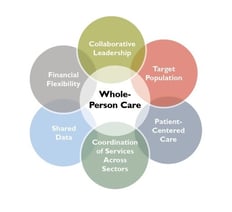Health in the United States is strongly correlated with income. By almost any measure, people with less money are less healthy. As evidence around social determinants and patient outcomes grows, healthcare organizations are becoming increasingly attuned to addressing the needs of low-income patients.
 In low-income communities in particular, the factors that impact health stretch far beyond doctors’ visits or emergency room encounters. Nutrition sources, housing access, mental health experiences, and unemployment, while often not thought of as “healthcare,” can exacerbate individual health issues and drive up the cost of care.
In low-income communities in particular, the factors that impact health stretch far beyond doctors’ visits or emergency room encounters. Nutrition sources, housing access, mental health experiences, and unemployment, while often not thought of as “healthcare,” can exacerbate individual health issues and drive up the cost of care.
Treating – or even understanding – the full scope of a person’s health needs is not easy. Health systems, community providers, social resources, and government entities are often siloed across different organizations, and communication between them is fragmented and inconsistent. Bridging these silos and improving overall care coordination is critical to improving outcomes, reducing costs, and succeeding in the transition to value-based care.
One of the biggest challenges for the healthcare industry in the next 10 years will be determining how to engage all these different organizations, align their services and resources within a patient’s care pathway, and ensure patients have timely access to these services to address their diverse and complex care needs.
In California, the healthcare industry is working on a solution: the $3 billion Medi-Cal pilot Whole Person Care. Whole Person Care aims to provide vulnerable populations with better care at a lower cost by treating the entire spectrum of health issues and improving communication between these siloed sources.
So far, California has approved more than 30 pilot sites for the program. At Nordic, we’re working with Contra Costa Health Services (CCHS) to use its EHR technology to better understand the needs of its patient population and help the organization tailor care based on that understanding.
Whole Person Care at Contra Costa Health Services
At CCHS, the organization has created a risk model that uses predictive modeling to understand patient vulnerabilities. Determining true patient risk is complex, and the ability to assign a risk score is only as good as the data used to create it.
 CCHS incorporates medical, social, and behavioral data to identify patients who may be high utilizers of multiple systems. Extending the risk modeling to leverage social determinants from as many sources as possible – including the housing information system, detention health, health plan, public health outreach system, and mental health and substance abuse data – allows CCHS to build a more robust and reliable risk score while also better understanding individual patient needs.
CCHS incorporates medical, social, and behavioral data to identify patients who may be high utilizers of multiple systems. Extending the risk modeling to leverage social determinants from as many sources as possible – including the housing information system, detention health, health plan, public health outreach system, and mental health and substance abuse data – allows CCHS to build a more robust and reliable risk score while also better understanding individual patient needs.
CCHS can then use this predictive risk modeling to develop patient enrollment programs and establish a single patient registry. CCHS uses its registry to assign high-risk patients to the right staff for their particular issue. For example, a patient with a history of substance abuse admissions may be assigned to a substance abuse counselor as their case manager, while a patient with a diagnosis of severe mental health disease may be assigned to a mental health clinical specialist.
To date, CCHS has reached capacity with an enrollment of 14,400 patients, nearly five percent of the county’s 290,000 Medi-Cal population.
To support patient enrollment, CCHS is expanding its care coordination team and building EHR documentation tools for community health workers, social workers, substance abuse counselors, mental health clinical specialists, public health nurses, homeless support, and eligibility specialists.
Nordic’s role in optimization
Nordic is helping CCHS optimize its Epic EHR to include patient registries, documentation tools, and reporting capabilities, which help the care coordination staff provide efficient, quality care. The optimization also allows for other CCHS care providers – such as MDs, RNs, and others – to view information about the social determinants of health and use that information to provide more comprehensive and coordinated care.
One such use case for the new Epic tools is a SmartForm that allows the care coordination staff to document each patient’s quality of life and social needs screening.
The SmartForm triggers a standardized, goal-based plan of care, which focuses on the physical, social, and behavioral needs identified for the patient. This goal-based plan of care is available to both healthcare providers and the patient through MyChart, which assists in long-term care management and patient engagement.
Coordinators also have access to patient management tools and reports in both Epic and Qlik. These tools allow staff to manage their panel of patients and view critical care reminders such as care outreach call reminders.
The toolset also informs the care managers of pertinent events such as loss of insurance eligibility, ED visits, and inpatient visits. To further improve care management, CCHS has implemented other technologies including EDIE, a database of patient ED data for real-time actionable insight; PreManage, a care management tool; a new Homeless Management Information System (HMIS); and Health Leads Reach, an EHR for social determinants. These tools, as well as new interfaces with multiple systems, are used to increase data connections, close information gaps, and provide more informed and coordinated care across the entire county.
What this means to us
At Nordic, patients and their families are at the heart of everything we do, and we recognize that vulnerable patients have the most need of everyone we serve.
Serving those patients is a tremendous challenge for the healthcare industry, and we believe that EHRs have a unique ability to connect disparate providers, engage patients in their own care, and improve the health of individuals and communities.
That’s why our partnership with Contra Costa is so meaningful to us. If you're interested in hearing more or connecting on your own patient-centric care initiatives, please reach out to us. We would love to discuss.
